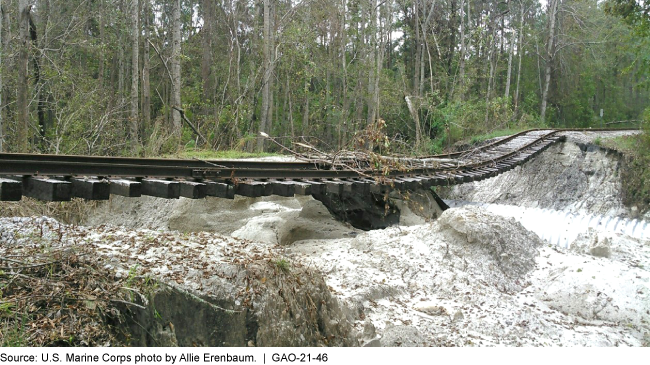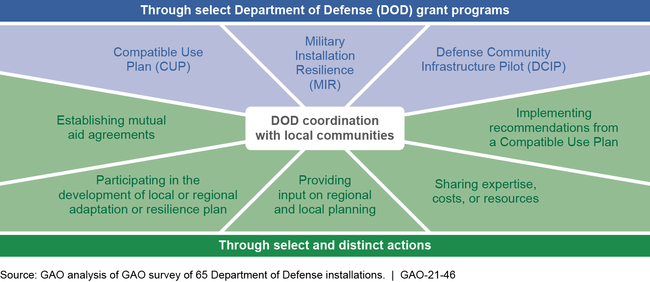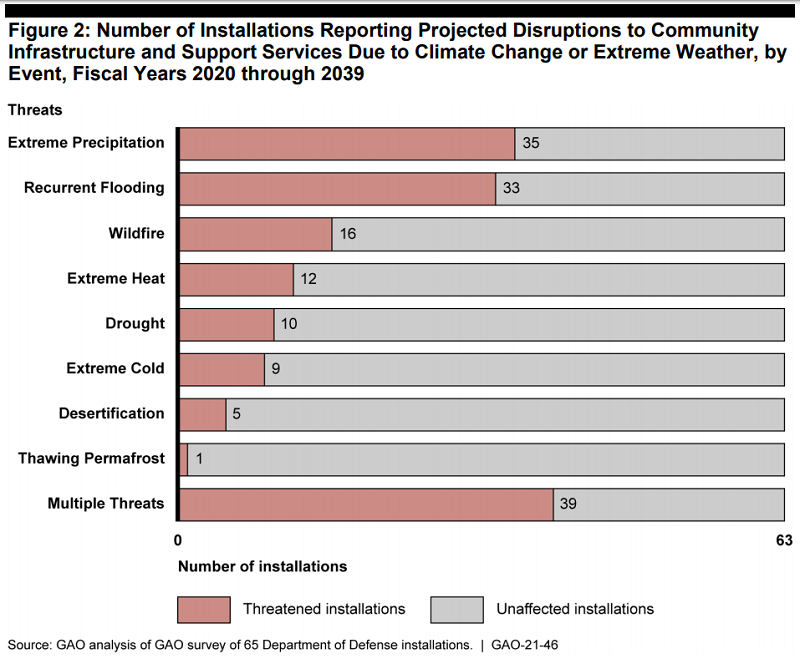Like a good neighbor, the DOD is there
There are more than 400 military installations in the United States, with hundreds of thousands of personnel stationed at sites from Andrews Air Force Base to Fort Bragg to the Puget Sound Naval Station. Some of those sites are isolated training grounds but others are closely tied to their neighboring communities.
Coordinated planning is key in those areas, where communities and military installations share some of the same infrastructure, services, and concerns. To address these issues, communities are using several federal programs to develop new land use regulations, transportation studies, emergency management plans, environmental assessments, and designs to mitigate climate change impacts.
The U.S. Department of Defense is a major supporter of coordination between communities and installations with its grant programs through the Office of Local Defense Community Cooperation. The funding allows communities to study and address “compatible use” challenges, climate resilience, and local infrastructure used by military personnel.
The Southeastern Connecticut Council of Governments is currently using a federal grant from the Military Installation Sustainability-Compatible Use program to study transportation issues in the city of Groton. The $265,000 grant will help the community identify recommendations to meet increased parking demands associated with the expansion of the Electric Boat’s facilities for assembling new Columbia-class submarines, according to an article in The Day.

A rail at Camp Lejeune in North Carolina is flooded during the 2018 Hurricane Florence. (Source: Allie Erenbaum)
The Central Savannah River Area Regional Commission in Georgia has been part of a coordinated planning effort between Fort Gordon and the surrounding communities. A Compatible Use Study was prepared several years ago, and in 2021 the Commission issued an RFP to implement some of the study’s recommendations. Those recommendations included follow-up planning and studies to address noise from military training and light pollution from development near the installation. According to the RFP: “Night training is an important component of the military training mission, and the degradation of the dark sky environment may threaten the installation’s ability to train and operate. … Currently, no counties bordering Fort Gordon have dark sky regulations or current documentation of ambient night lighting.”
IMS has tracked dozens of these grant-funded projects for its architectural, engineering, and consulting clients. IMS provides the information through daily leads from RFPs/RFQs and in Advance Notices of upcoming projects. Some of these recent projects include:
* The Metropolitan Washington Council of Governments in D.C., released an RFP in December 2020 to prepare a community stakeholder planning process for the Military Installation Resilience Review Program at Joint Base Anacostia Bolling, the Navy Research Laboratory, Washington Navy Yard, Fort Lesley J. McNair (IMS 546921).
* The Lowcountry Council of Governments in South Carolina issued an RFP in December 2020 to conduct a Military Installation Resilience Review for Marine Corps Air Station-Beaufort, Marine Corps Recruit Depot-Parris Island, and the surrounding communities that provide much of the infrastructure for the military installations (IMS 543605-1).
* The City of Annapolis, Md., released an RFP in December 2020 for land use, transportation, emergency management, and resilience planning services related to operations at the Naval military installation complex and surrounding communities (IMS 543957).
* In Mississippi, the Gulf Regional Planning Commission released an RFP in October 2020 to study compatible use among private sectors and the Naval Construction Battalion Center Gulfport and Keesler Air Force Base. The project will also develop resilient energy strategies that strengthen the Mississippi Gulf Coast against all disasters under a DOD Compatible Use and Military Installation Sustainability Grant (IMS 536419-1).
* Coconino County, Ariz., issued an RFP in October 2020 to support the Joint Land Use Study for Camp Navajo. The project will review dark sky-compliant lighting and wildfire threats (IMS 535613).
* In Utah, the Mountainland Association of Governments released an RFP in October 2020 for a regional study of Camp Williams to identify locations of possible land use conflicts between the civilian population and the military installation (IMS 538419).

The DOD works extensively with local communities, providing funding and support to ensure a range of shared public services operate smoothly. (Source: U.S. Government Accountability Office)
* Riverside County, Calif., released an RFP in August 2020 to prepare the March Air Reserve Base/Inland Port Compatible Use Study and Report to address the needs of the base and adjacent/impacted areas. The study included a review of flooding potential from development around the installation, landscaping that could lead to wildlife hazards for aircraft, and increased glare from reflective roof surfaces and solar panel/photovoltaic development (IMS 530620).
* The Town of Kittery, Maine, released an RFP in July 2020 to assist with implementing the Portsmouth Naval Shipyard’s 2019 Joint Land Use Study related to transportation, housing, and communications (IMS 526240).
* The City of Sierra Vista, Ariz., issued an RFP in July 2020 for a joint resource utilization study on sustaining the Army’s missions at Fort Huachuca in a compatible use with local communities (IMS 525997).
* The Abilene Housing Authority in Texas released an RFP to address the Joint Land Use Study for Dyess Air Force Base. The project included updating zoning ordinances, preparing a Compatibility Resource Guide, and providing noise attenuation education materials (IMS 526116).
* City of Monterey, Calif., released an RFP in January 2020 for a Compatible Use Plan for the Presidio of Monterey, Naval Support Activity Monterey, Defense Manpower Data Center Monterey Bay, Fort Hunter Liggett, and Camp Roberts. The Project goal was to address the encroachment and compatibility issues confronting the civilian community and the installations (IMS 500347).
These projects show the wide range of planning, engineering, mapping, outreach, and environmental services that are needed by communities and military bases. The “sustainability factors” that can be studied through Department of Defense grants are also wide-ranging: light pollution, urban growth, energy project siting, key infrastructure access, noise, electromagnetic spectrum interference, protection from unmanned aerial and underwater vehicles, and endangered species.
Increasingly, climate change issues – how to deal with flooding, fires, and extreme weather – are coming to the forefront.
A report in December 2020 from the US Government Accountability Office assessed how the Department of Defense uses the infrastructure of neighboring communities and how the Department is coordinating with those communities to mitigate the effects of climate change and extreme weather.

The DOD projects an increasing number of installations threatened by climate change over the next 20 years. Safeguarding these installations, and the infrastructure of nearby civilian communities, will make sure the U.S. military remains prepared to fulfill its mission both at home and abroad. (Source: U.S. Government Accountability Office)
The GAO noted that about $67 million was awarded to local communities in fiscal year 2020 for the Compatible Use Plan, Military Installation Resilience, and Defense Community Infrastructure Pilot grant programs.
That seems like a good investment in local planning, since the “DOD manages a domestic real-estate portfolio with an estimated replacement value of nearly $930 billion, including installations in all regions of the continental United States, Alaska, and Hawaii,” according to the GAO report.
Those military installations rely on a local community’s roads, bridges, ports, water services, electricity, dams, and other infrastructure. Indeed, all 63 installations in the GAO’s survey used at least some form of a local community’s infrastructure and support services. Thus, the military installations, through those Department of Defense grants, are supporting local planning and engineering to protect infrastructure from flooding, drought, wildfire, extreme heat, and other climate change impacts.
The GAO said new performance measures are needed to assess the outcomes from those three major Department of Defense grants. But the report also documented an “extensive use of community infrastructure” and significant coordination between military installations and local public utilities, counties, emergency organizations, planning boards, and public works departments.
The report said the three grants “provide key mechanisms and funding for military installations and communities to coordinate on climate resilience issues, including through joint land use studies and community infrastructure development.”
As IMS has seen in dozens of RFPs, expertise from A/E/C professionals is often needed to understand the complex and varied issues of sustaining the military’s mission and a community’s quality of life. The coordination is critical where bases or communities are expanding, where infrastructure cannot meet demands, and in areas threatened by flooding or sea level rise.